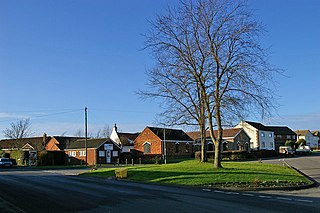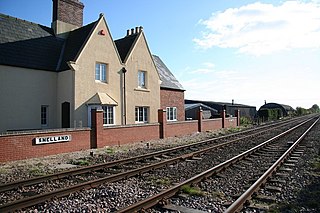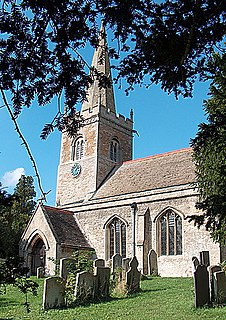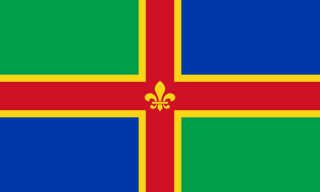
Hornsea is a small seaside resort, town and civil parish in the East Riding of Yorkshire, England. The settlement dates to at least the early medieval period. The town was expanded in the Victorian era with the coming of the Hull and Hornsea Railway in 1864.

Crowle is a populous community in the civil parish of Crowle and Ealand, on the Isle of Axholme in North Lincolnshire, England. The civil parish had a population at the 2011 census of 4,828. It lies on the Stainforth and Keadby Canal and has a railway station. The place has a further named neighbourhood, Windsor.

Howell is a hamlet in the North Kesteven district of Lincolnshire, approximately 1 mile (1.6 km) north of the A17, 4 miles (6 km) east from Sleaford, and 1.5 miles (2.4 km) north from Heckington. It is in the civil parish of Asgarby and Howell.

Healing is a village and civil parish in North East Lincolnshire, England. It is situated between Stallingborough and Great Coates, and 3 miles (5 km) west from Grimsby.

The Ruthwell Cross is a stone Anglo-Saxon cross probably dating from the 8th century, when the village of Ruthwell, now in Scotland, was part of the Anglo-Saxon Kingdom of Northumbria.

South Killingholme is a village and civil parish in North Lincolnshire, England. The population of the civil parish at the 2011 census was 1,108.
Aby with Greenfield is a civil parish in the East Lindsey district of Lincolnshire, England. The population of the civil parish at the 2011 Census was 196. It consists of the villages of Aby and Greenfield. The parish is situated approximately 7 miles (11 km) south-east from Louth.

St John's Church, Ranmoor is a large parish church in Ranmoor, a suburb of the City of Sheffield, England. It is a Church of England church in the Diocese of Sheffield, and it is the second church to be built on this site. The original church, designed by E.M. Gibbs, was opened 24 April 1879. This building was almost entirely destroyed by fire on 2 January 1887; all that survived was the 200-foot-tall (61 m) tower and spire. A new church, designed by Flockton & Gibbs, was built that incorporated the old tower and spire. The church reopened on 9 September 1888; it is a Grade II* listed building.
Elkington is a civil parish in the East Lindsey district of Lincolnshire, England. It comprises the village of South Elkington, and the hamlets of North Elkington, Boswell, and Thorpe, and is situated approximately 3 miles (5 km) north-west from the market town of Louth.
Wyville with Hungerton, or Hungerton-cum-Wyville is a village and civil parish in the South Kesteven district of Lincolnshire, England, and situated approximately 5 miles (8 km) south-west from Grantham The whole parish covers about 1,670 acres (6.8 km2). The population is included in the civil parish of Little Ponton and Stroxton.

Snelland railway station was a station in Snelland, Lincolnshire, opened in 1848 as part of the Sheffield and Lincolnshire Extension Railway. and closed in 1965.

Haxey and Epworth railway station was located near Haxey, Lincolnshire, England. It closed to passengers in 1959 and completely in 1964.

Bonby Priory was a priory in Lincolnshire, England. St. Andrews Church is all that remains of Bonby Priory, which was a Benedictine alien cell of St. Fromond Priory from 1199 to 1403. The priory was then rented to Beauvale Abbey, (Nottinghamshire), and later, the church became parochial.

Newland is a suburb of Kingston upon Hull, East Riding of Yorkshire, England, in the north-west of the city, a former village on the Hull to Beverley turnpike.

Hannah cum Hagnaby is a civil parish in the East Lindsey district of Lincolnshire, England. It is situated approximately 4 miles (6 km) north-east from Alford, and 15 miles (24 km) south-east from Louth The parish contains two small hamlets, Hannah and Hagnaby. Hannah was used in the Bronze age as there is evidence of a Round Barrow. In antiquity Hannah was known as Hannay. The church, located in Hannah, is dedicated to Saint Andrew and is a Grade I listed building, built of greenstone about 1758, with early 19th, and some 20th-century, alterations.

Haltham is a village and civil parish in the East Lindsey district of Lincolnshire, England. The population of the civil parish at the 2011 Census was 122. It is situated 4 miles (6.4 km) south from the town of Horncastle, and on the east bank of the River Bain in the Lincolnshire Wolds, a designated Area of Outstanding Natural Beauty.

Sutton St James is a village and civil parish in the South Holland district of Lincolnshire, England, about four miles (6.4 km) south-west of Long Sutton.

The church of St Medardus and St Gildardus in Little Bytham, Lincolnshire, England, is a Grade I listed building. It is dedicated to two 6th-century French saints, St Medard and St Gildard ; the dedication is unique in the UK. Virtually unknown in Britain, St Medard is still well known in France, with at least 25 towns or villages named after him. Gildard, thought to be his brother, is less well known. The village fête is held annually on or near St Medard's feast day, 8 June.

The Church of St Paul in Stamford, Lincolnshire, England, was one of the town's fourteen Medieval parish churches until its deconsecration and extensive demolition during the Reformation when the remaining part became used as the schoolroom of Stamford School. It was then restored and extended in 1929-30 for use as the school chapel in commemoration of those old boys and staff who had died in the First World War. The medieval remains were the eastern part of the south aisle and adjacent fragments of the nave of the church.

Grid Reference SK 48903 37350





















